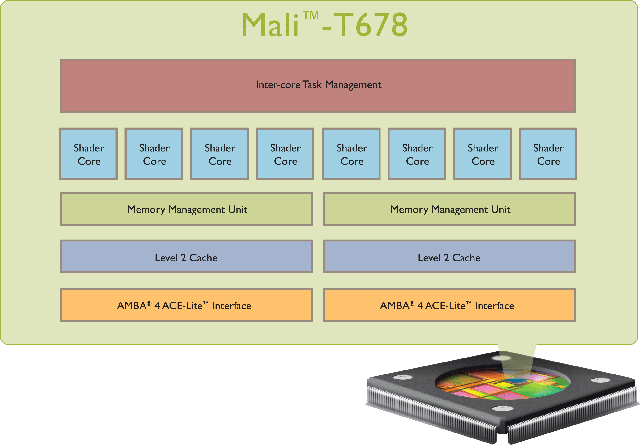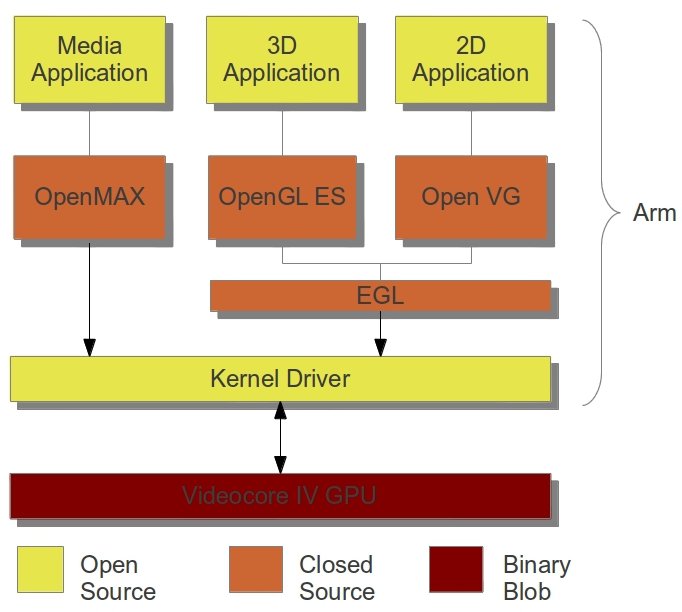ARM announced the second generation of the Mali-T600 Series GPUs targeting tablets, smartphones and smart TVs. Those new GPUs provide up to 50% performance increase over the first generation Midgard GPUs (T-604 & T-658) and include support for Adaptive Scalable Texture Compression (ASTC), a texture compression technique. The company explains that ASTC significantly optimizes GPU performance and increases battery life in devices. Those 3 new GPUs based on Mali Midgard architecture are named as follows: Mali-T624 – 1 to 4 cores – Market: Smartphones and smart-Tvs Mali-T628 – 5 to 8 cores – Market: Smartphones and smart-Tvs Mali-T678 – Up to 8 cores, 4x the GPU compute performance of Mali-T628 – Market: Tablets As with previous Midgard GPUs, the new GPUs support GPU compute with improves performance and energy-efficiency for math intensive activities, such as: Computational photography – computational methods of enhancing or extending digital photography Multi perspective views – […]
Ziilabs ZMS-40 Decodes 6 HD Videos and Maps them to 3D Objects Simultaneously!
Ziilabs uploaded an impressive video that shows the Ziilabs ZMS-40 simultaneously decoding 6 High Definition Videos (although they don’t say if it’s 720p or 1080p) with 5 H.264 videos and 1 VP8/WebM video and rendering them on 3D objects via OpenGL ES. That’s quite amazing, but the next question could be why would you need that much processing power in a chip aimed at tablets? Augmented reality perhaps… Jean-Luc Aufranc (CNXSoft)Jean-Luc started CNX Software in 2010 as a part-time endeavor, before quitting his job as a software engineering manager, and starting to write daily news, and reviews full time later in 2011. www.cnx-software.com
Nokia Qt Labs Releases Qt 5.0 Alpha
Nokia Qt Labs announced the alpha release of Qt 5 C++ application development framework, which focuses on the delivery of Qt Essential modules for Qt 5. This new version of Qt goal is to bring the focus to a model, although native Qt using C++ would still be used to implement modular backend functionality for Qt Quick. The developers explains that this module is working nicely on Qt for embedded system where UIs are full screen, but more work is needed on the desktop, and it will only be fully implemented in Qt 5.1 or 5.2. Qt developers make 4 big architectural changes to Qt internal architecture: Base all Qt ports on Qt Platform Abstraction layer (QPA) to make it easier to port Qt to other windowing systems and devices. Re-architect Qt graphics stack using a a Scenegraph on top of OpenGL to increase performance versus Qt 4, using Qt […]
Linaro 12.02 Release with Kernel 3.3-rc
Linaro has just released version 12.02 based on Linux Kernel 3.3-rc and Android 4.0.3. Among the key points, they have started to work on Freescale i.MX6 SabreLite board, included libav 0.8 to Ubuntu images which provides up to 160% performance improvement while playing real-media videos and XBMC is available via PPA. Here are the highlights of the release: Android Linaro Android can now be built with current GCC 4.7 snapshots. A 4.7 based toolchain build preview is also available. Linaro Android can boot on iMX6 Sabrelite boards. All test result spreadsheets have been streamlined and are now easier to use. Bluetooth enablement have been completed for the Origen board. A Prototype of using camera on Snowball was made. Presentations Given by Linaro Android Team this cycle “Binary Blobs Attack!!!” – Embedded Linux Conference. “What Android and Embedded Linux can learn from each other” – Embedded Linux Conference. “Integrating Projects Using […]
Raspberry Pi OpenGL and OpenMAX IL “Hello World!” Applications
As you may already know, Raspberry Pi has released their first SD card image with Debian. This morning, I explained how to use that image in qemu. I’ve been waiting for samples to take advantage of the power Videocore GPU inside Broadcom BCM2835 SoC used in the Raspberry Pi board and the goods news is that they added Hello World code samples in C to make use of those capabilities. The sample are located in /opt/vc/src/hello_pi directory: hello_audio – Audio output demo using OpenMAX IL through the ilcient helper library hello_triangle – A rotating cube rendered with OpenGL ES with 3 images used as textures on the cube faces. hello_video – Video decode demo using OpenMAX IL through the ilcient helper library You can either compile those samples in the board or cross-compile them in your host machine. Since you need the GPU, you will obviously not be able to […]
Wayland Library: X11 Display Server Replacement for Linux
The X Window System has been implemented in Linux since the beginning and manages the graphical user interface of most Linux distributions, although some embedded systems do without X11 and use lightweight graphics libraries such as Nano-X, SDL, DirectFB etc… X11 is invisible to the end-user but does all the hard work needed to have Gnome, KDE and Unity user interfaces work properly and smoothly. However, in recent years, GNU/Linux desktop graphics has moved from having numerous rendering APIs talking to the X server which manages everything towards putting the Linux kernel in the middle with direct rending (e.g. OpenGL, VDPAU/VAAPI) with window systems taking the backstage. This new architecture provides a much-simplified graphics system offering more flexibility and better performance. The problem is that the X Window System is highly complex, a complexity that is not really needed with the newest version of the kernel. That’s where Wayland protocol comes […]
Raspberry Pi Codecs and Graphics/Video APIs
The Raspberry Pi Foundation has announced which codecs and API would be supported in the Raspberry Pi. The Raspberry Pi board will support the following Graphics and Video API via a set of closed source libraries that give access to the GPU acceleration features: OpenGL ES 2.0 – OpenGL is a 3D Graphics API defined by the Khronos Group. OpenVG – OpenVG is a 2D vector drawing API also defined by the Khronos Group. EGL – EGL is the interface between Khronos rendering APIs such as OpenGL ES or OpenVG and the underlying native platform window system. OpenMAX IL – OpenMAX supplies a set of API’s that provides abstractions for routines used during audio, video, and still images processing. OpenMAX defines 3 layers, Raspberry Pi library will provide an interface to the IL layer, which provides an interface between media framework such as Gstreamer and a set of multimedia components. […]
Android Developers Conference 2012 (AnDevCon III) Schedule
The full schedule for AnDevCon III (14-17 May 2012) has finally been released with 42 different classes and several workshops. The sessions will be organized into five subject area: Developer Essentials: These technical classes and workshops are for all Android developers and cover all programming topics. Android Enterprise: These technical sessions cover topics specific to building and managing apps for employees, business customers and partners, such as back-end integration corporate data center communications, ERP or CRM systems. Android Business: These classes and workshops are for entrepreneurial developers who want to learn the most effective ways of distributing and selling Android apps, including how to maximize profit through the Android Market. Android Tablets and beyond: These classes and workshops are specific to commercial devices beyond smartphones, including tablets, Google TV, and other platforms. Embedded Android: These classes and workshops are for developers working close to the hardware, such as on custom […]






